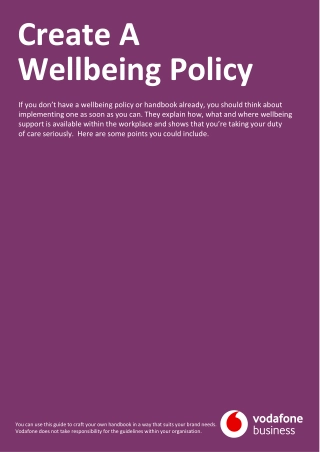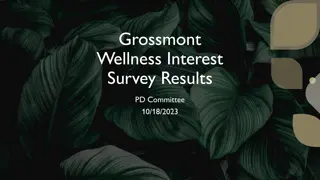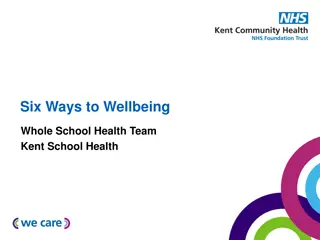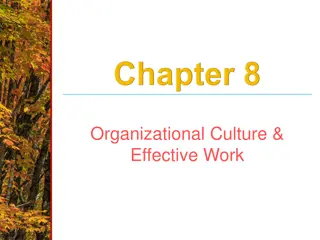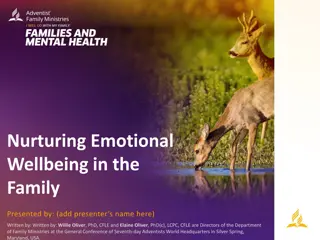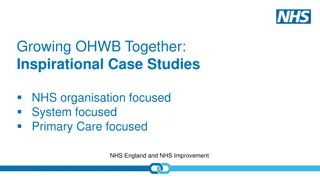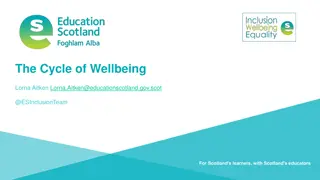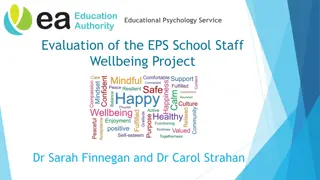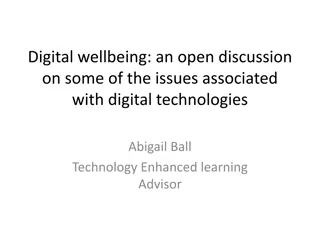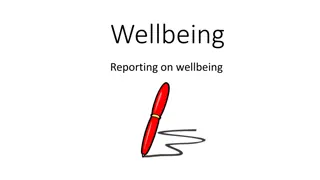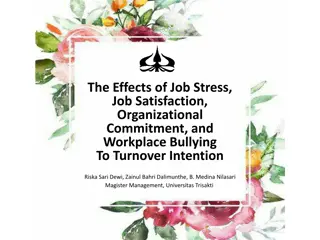The Importance of Workplace Wellbeing for Organizational Success
Workplace wellbeing is crucial for organizational success as it impacts employee engagement, productivity, and turnover rates. Organizations like Wellspring Community mental health agency face challenges due to high turnover and associated costs, emphasizing the need for creating a healthy workplace environment that addresses factors like emotional exhaustion, work demands, and support systems. By focusing on the drivers of workplace wellbeing and fostering a positive working environment, organizations can enhance employee satisfaction and performance while reducing turnover expenses.
Download Presentation

Please find below an Image/Link to download the presentation.
The content on the website is provided AS IS for your information and personal use only. It may not be sold, licensed, or shared on other websites without obtaining consent from the author.If you encounter any issues during the download, it is possible that the publisher has removed the file from their server.
You are allowed to download the files provided on this website for personal or commercial use, subject to the condition that they are used lawfully. All files are the property of their respective owners.
The content on the website is provided AS IS for your information and personal use only. It may not be sold, licensed, or shared on other websites without obtaining consent from the author.
E N D
Presentation Transcript
WELLSPRING Community mental health agency: 900 employees; residential, outpatient therapy, community/school/prison-based therapy, med-management, case management CEO 25+ years, ready to retire, $4M budget at start $40M budget 39% turnover, up to 46% of frontline staff Expos on CEO s salary Pay as low as $10.10/hr
THE IMPORTANCE OF WORKPLACE WELLBEING Indirect organizational costs: loss of institutional knowledge, employee engagement, and productivity Direct organizational costs through turnover expenses Voluntary employee resignations at a 20-year peak Wellspring: 39%=351 employees or $1.76M Wellspring staff: continuity of care and not replacing staff Wellspring: peaked at 42% in 2016 Turnover reduces organizational performance, takes $ away from program investments for recruitment and training costs Half of all mid-level managers trying to change jobs $8k to replace $40k manager Wellspring: employees leave their jobs because of supervisors not because of the agency Wellspring: $5k as mostly frontline turnover Wellspring: $1.76M
CREATING A HEALTHY WORKPLACE The10 drivers of Workplace Wellbeing EMOTIONAL EXHAUSTION tired, worn out, overwhelmed WORK ENGAGEMENT absorbed, energized, challenged, focused COLLEAGUE SUPPORT helped, supported, respected, listened to SUPERVISOR SUPPORT good feedback, helpful, understanding, encouraging WORK DEMANDS unachievable expectations, intense, too much to do, pressure CONTROL/AUTONOMY choice in what and how work is done, flexibility INTERPERSONAL RELATIONSHIPS harassment, friction, bullying JOB ROLE clarity of duties and responsibilities, goals and objectives ORGANIZATIONAL CHANGE employee involvement in change DISTRIBUTIVE JUSTICE fairness in pay, praise, workload, rewards
CREATING A HEALTHY WORKPLACE Build Positive Sentiment Override (PSO) Attributes that build PSO Employees agency's greatest asset Attributes that undermine PSO Employees replaceable and expendable All employees deserve opportunity and guidance Only select employees deserve opportunity Concern foremost for employee personal wellbeing Relationship building not a priority Rewards distributed fairly and reasonably Rewards distributed favoring select individuals or groups Maintain status quo, assume employees unable to handle difficult information Hard questions asked and answered publicly Collaboration produces best results; everyone can win Competition produces best results, only some can win Hard work and skill recognized Hard work and skill taken advantage of at employee expense Management doesn t listen or respond, communication flows only one way Management listens and responds Transparent communication leads to inclusiveness Lack of communication leads to distrust and confusion
THE OCCUMETRICS PROCESS Thorough and anonymous information gathering process Allows us to spend the time that businesses and organizations likely do not have to listen carefully to employee issues from micro to macro Wellbeing Profile provides participants with comprehensive, straightforward recommendations
WELLBEING PROFILE THE OCCUMETRICS PROCESS STEP 1 | ASSESS Analyzing the Numbers Research-based, in-depth survey, data analysis STEP 2 | ENGAGE Listening to Conversations Follow-up focus groups informed by survey results Customized recommendations to address issues at hand STEP 3 | CHANGE Learning from Your Workforce
STEP 1 ASSESS | ANALYZING THE NUMBERS 58-questions assessing 10 drivers of workplace wellbeing Client provides researchers with Turnover rates Exit interview summaries Correlation and regression analyses What are the most common drivers of turnover intention and dissatisfaction in the workplace? Results inform what to explore in focus groups
STEP 2 ENGAGE | LISTENING TO CONVERSATIONS Deep dive into issues identified in survey data: Five to eight one-hour focus groups of 8-12 employees each (one group of supervisors only) Interview with CEO/Leadership Team
STEP 3 CHANGE | LEARNING FROM YOUR WORKFORCE Understand our findings Discuss what they mean for the client Process customized recommendations addressing the issues
PUTTING IT TOGETHER WELLSPRING 2017 voluntary turnover rate 37% Highest among direct service and frontline staff Lower among leadership, supervisors, managers Frontline staff turnover 46% over latest 3-year period Diminishes capacity fuels staff burnout weakens service quality, productivity
PUTTING IT TOGETHER WELLSPRING Most motivated by Mission-driven work Engaging with clients, seeing improvement Flexibility, autonomy Mostly supportive coworkers, supervisors Ability to grow within the company Most discouraged by Feeling underpaid Feeling short-staffed, overworked Feeling unimportant, undervalued Experiencing poor communication from top down & among departments & locations, lack of clear & considerate communication from sr. mgt. Lengthy, inefficient hiring process
STEP 1 ASSESS | ANALYZING THE NUMBERS Work Benefits Satisfaction Work Demands Pay Interpersonal Relationships Engagement Satisfaction Most Impactful Drivers in Turnover Intention (Wellspring)
STEP 2 ENGAGE | LISTENING TO CONVERSATIONS Work Demands: workloads unrealistic, unattainable Emotional Exhaustion: feeling overworked; responsibility piles on when staff leave Pay: dissatisfied, underpaid, lower than comparable agencies, challenge to recruit quality staff Benefits: varied feedback on PTO/vacation time potential time off appreciated but no time to take it, mostly satisfied with healthcare benefit Organizational Change: lack of good communication from leadership & among locations & departments, top heavy , no voice in change Colleague Support: mostly positive, good relationships within sites, some mistrust & feelings of favoritism between sites Supervisor Support: varied depending on skills of supervisors
STEP 3 CHANGE | LEARNING FROM YOUR WORKFORCE General Recommendations for Wellspring: Address wage concerns compensation plan , livable wage, targeted wage increases Assess workloads able to manage more work without compromising quality/productivity Prioritize Positive Sentiment Override(PSO) build trust Modify centralized hiring process improve efficiencies & appropriate hiring Improve communication channels top down & among departments/locations, reduce negative feelings, promote understanding & appreciation of roles/responsibilities Create agency-specific communication module within existing supervisor training, importance of supervisor s role in effective mngt. & flow of info
UPDATE | WELLSPRING IMPLEMENTATION To date: HR Department Business partner model Personnel changes Less time between initial interview & hire Better on-barding, increased visibility of executive staff Compensation Higher wages for lowest paid Second shift & holiday differentials New compensation plan incl. communication about wage ranges/increases, etc. Communication More than email Employee Advocates through HR managers for continuous feedback Building trust establishing PSO
OCCUMETRICS WORKS OCCUMETRICS PARTICIPANT, ONE YEAR AFTER INCORPORATING RECOMMENDATIONS 51% 39% Turnover before Turnover after 12% reduction in staff turnover, 33 retained employees Saved $266,000
OCCUMETRICS FOR YOUR AFFILIATE? Affiliate: Recruit & cultivate client MHAFC: Administer survey, analyze data, propose focus group questions STEP 1 | ASSESS Analyzing the Numbers Affiliate: Conduct focus groups, take notes MHAFC: Train affiliate to conduct focus groups STEP 2 | ENGAGE Listening to Conversations Affiliate: Present findings & recommendations to client using Occumetrics template MHAFC: Collaborate with affiliate to create individualized Wellbeing Profile using Occumetrics template STEP 3 | CHANGE Learning from Your Workforce
OCCUMETRICS FOR YOUR AFFILIATE? If your affiliate would like further information, please contact: Maggie Hallett, EdS, LPC mhallett@mhafc.org 614-221-1441 x 105 Kenton Beachy, MA, MPA kbeachy@mhafc.org 614-221-1441 x 101


